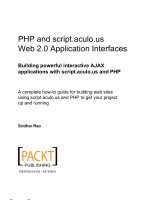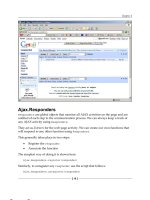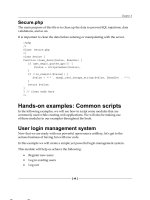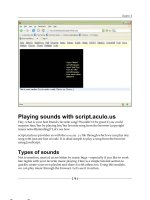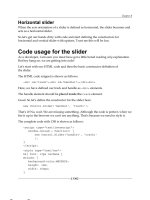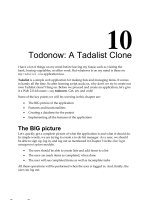course technology web 2.0 security, defending ajax ria and soa (2008)
Bạn đang xem bản rút gọn của tài liệu. Xem và tải ngay bản đầy đủ của tài liệu tại đây (5.82 MB, 385 trang )
WEB 2.0 SECURITY:
D
EFENDING AJAX, RIA,
AND SOA
SHREERAJ SHAH
Australia • Brazil • Japan • Korea • Mexico • Singapore • Spain • United Kingdom • United States
Charles River Media
A part of Course Technology, Cengage Learning
© 2008 Course Technology, a part of Cengage Learning.
ALL RIGHTS RESERVED. No part of this work covered by the copyright
herein may be reproduced, transmitted, stored, or used in any form or by
any means graphic, electronic, or mechanical, including but not limited to
photocopying, recording, scanning, digitizing, taping, Web distribution,
information networks, or information storage and retrieval systems, except
as permitted under Section 107 or 108 of the 1976 United States Copyright
Act, without the prior written permission of the publisher.
Publisher and General Manager,
Course Technology PTR: Stacy L. Hiquet
Associate Director of Marketing:
Sarah Panella
Manager of Editorial Services: Heather
Talbot
Marketing Manager: Mark Hughes
Senior Acquisitions Editor: Mitzi Koontz
Project Editor: Karen A. Gill
Copy Editor: Ruth Saavedra
Technical Reviewer: Jaelle Scheuerman
CRM Editorial Services Coordinator:
Jen Blaney
Interior Layout Tech: Judith Littlefield
Cover Designer: Tyler Creative Services
CD-ROM Producer: Brandon Penticuff
Indexer: Kevin Broccoli
Proofreader: Sue Boshers
Printed in the United States of America
1 2 3 4 5 6 7 11 10 09 08
For product information and technology assistance, contact us at
Cengage Learning Customer & Sales Support, 1-800-354-9706
For permission to use material from this text or product,
submit all requests online at cengage.com/permissions
Further permissions questions can be emailed to
Library of Congress Control Number: 2007939356
ISBN-13: 978-1-58450-550-1
ISBN-10: 1-58450-550-8
Course Technology
25 Thomson Place
Boston, MA 02210
USA
Cengage Learning is a leading provider of customized learning solutions
with office locations around the globe, including Singapore, the United
Kingdom, Australia, Mexico, Brazil, and Japan. Locate your local office at:
international.cengage.com/region
Cengage Learning products are represented in Canada by
Nelson Education, Ltd.
For your lifelong learning solutions, visit courseptr.com
Visit our corporate website at cengage.com
eISBN-10: 1-58450-606-7
This book is dedicated to my grandmother (Vasuben),
mother (Rekhaben), and sisters (Reena and Rajvee)
for their love, support, and guidance.
I am deeply thankful for their help through all these years.
This page intentionally left blank
Acknowledgments xi
About the Author xiii
Introduction xv
1 Web 2.0 Introduction and Security 1
Web 2.0—An Agent of Change 2
Driving Factors for Web 2.0 and Its Impact on Security 2
Path of Evolution: A Look Back in Time and a Peek Ahead 3
Web 2.0: Technology Vectors and Architecture 4
Web 2.0 Application Information Sources and Flow 7
Real-Life Web 2.0 Application Examples 8
Growing Web 2.0 Security Concerns 9
Web 2.0 Real-Life Security Cases 11
Conclusion 12
2 Overview of Web 2.0 Technologies 13
Web 2.0 Technology Layers: Building Blocks for
Next Generation Applications 14
Client Layer 15
Rich Internet Applications 24
Protocol Layer 27
Structure Layer 35
Server Layer 40
Conclusion 45
Contents
v
3 Web 2.0 Security Threats, Challenges, and Defenses 47
Web 2.0 Security Landscape 47
Web 2.0 Security Cycle and Changing Vectors 49
Web 2.0 Attack Points and Layered Threats 53
Conclusion 70
4 Web 2.0 Security Assessment Approaches, Methods, and Strategies 71
Web 2.0 Security Assessment 71
Web 2.0 Application Assessment Methods 72
Conclusion 77
5 Web 2.0 Application Footprinting 79
Web 2.0 Footprinting Basics 79
Web Services Footprinting 87
Footprinting Countermeasures 92
Conclusion 93
6 Web 2.0 Application Discovery, Enumeration, and Profiling 95
Web 2.0 Application Discovery: Problem Domain 96
Web 2.0 Application Discovery with Protocol Analysis 96
Dynamic DOM Event Manipulation 103
Crawling Ajax-Based Pages 105
Page Profiling and Linkage Analysis 111
Web Services Discovery and Profiling 112
Conclusion 117
7 Cross-Site Scripting with Web 2.0 Applications 119
XSS 120
XSS Basics 120
XSS and Serialization with Applications 128
Conclusion 136
vi
Contents
8 Cross-Site Request Forgery with Web 2.0 Applications 137
CSRF Overview 137
CSRF with the
POST Method 144
Web 2.0 Applications and CSRF 145
CSRF and Getting Cross-Domain Information Access 151
Conclusion 158
9 RSS, Mashup, and Widget Security 159
Cross-Domain Security 160
RSS Security and Attacks 170
Mashup Security 176
Widget Security 179
Conclusion 181
10 Web 2.0 Application Scanning and Vulnerability Detection 183
Fingerprinting Web 2.0 Technologies 184
Ajax Framework and Vulnerabilities 190
Fingerprinting RIA Components 191
Scanning Ajax Code for DOM-Based XSS 194
RIA- and Flash-Based Component Decompilation 200
CSRF Vulnerability Detection with Web 2.0 Applications 202
JavaScript Client-Side Scanning for Entry Points 203
Debugging JavaScript for Vulnerability Detection 207
Conclusion 212
11 SOA and Web Services Security 213
Real-Life Example of SOA 214
SOA Layered Architecture 215
SOA Server-Side Architecture and Code 217
Web Services and SOA Security Framework 218
XML Message: A Torpedo of Web 2.0 Applications 220
Contents vii
SOA Threat Framework 221
SOA Security Challenges and Technology Vectors 235
Conclusion 236
12 SOA Attack Vectors and Scanning for Vulnerabilities 237
Profiling and Invoking Web Services 238
Technology Fingerprinting and Enumeration 242
XML Poisoning 245
Parameter Tampering 247
SQL Injection with SOAP Manipulation 256
XPATH Injection 258
LDAP Injection with SOAP 263
Directory Traversal and Filesystem Access Through SOAP 268
Operating System Command Execution Using Vulnerable Web Services 272
SOAP Message Brute Forcing 276
Session Hijacking with Web Services 279
Conclusion 280
13 Web 2.0 Application Fuzzing for Vulnerability Detection and
Filtering for Countermeasures 281
Web 2.0 Application Fuzzing 281
Web 2.0 Application Firewall and Filtering 288
Conclusion 303
14 Web 2.0 Application Defenses by Request Signature and
Code Scanning 305
Ajax Request Signature for Web 2.0 Applications:
Defense Against CSRF and XSS 306
Source Code Review and Vulnerability Identification 312
Conclusion 318
viii
Contents
15 Resources for Web 2.0 Security: Tools, Techniques,
and References 319
Discovery and Analysis Through a Proxy 320
Browser Plug-Ins for HTTP Traffic 323
JavaScript and Greasemonkey 324
Browser Automation 327
XSS Exploitation 329
Metasploit 3.0 and the Web 2.0 Layer 334
DOM and Developer Tools 336
XSS Attacks and Assistant 337
XSS and CSRF Defense Reference 338
SOAP Clients in Various Languages 340
SOAP Quick Reference 341
WSDL Quick Reference 342
UDDI Quick Reference 343
SOA Technologies 344
Web 2.0–Specific Resource Extensions for Files 344
SOA Checklist 345
Ajax Security Checklist 346
Web 2.0–Related Published Vulnerabilities 347
Index 353
Contents ix
This page intentionally left blank
I
thank all team members at Charles River Media for their support in every phase
of the process. My sincere gratitude goes to Mitzi Koontz, Karen Gill, Jennifer
Blaney, Heather Talbot, Brandon Penticuff, Jaelle Scheuerman, Sue Boshers,
Kevin Broccoli, and Judy Littlefield for their help. I express special thanks to Hedwig
Fernandes for helping me out in content review.
I also thank all security professionals and researchers who did great work in this
field by sharing their papers and knowledge. To make life easier, several authors
contributed excellent open source frameworks and tools, including but not limited
to Paros proxy, Burp proxy, BeEF, Metasploit, Greasemonkey, Sahi, LiveHTTP-
Headers, XSS-Proxy, Firebug, XSS Assistant, Chickenfoot, and AttackAPI. I appre-
ciate their contribution and am thankful for their support of the community
for better Web 2.0 security. Finally, I thank my wife Minti for her support and my
little daughter Aaryaa for her smile—truly inspirational.
Acknowledgments
xi
This page intentionally left blank
Shreeraj Shah, B.E., M.S.C.S., M.B.A., is the founder and director of Blueinfy, a
company that provides application security services. Prior to founding Blueinfy, he
was founder and board member at Net Square. He has also worked with Found-
stone (McAfee), Chase Manhattan Bank, and IBM in security space.
He is the author of popular books such as Hacking Web Services (Thomson 2006)
and Web Hacking: Attacks and Defense (Addison-Wesley 2003). In addition, he has
published several advisories, tools, and white papers and has presented at numerous
conferences including RSA, AusCERT, InfoSec World (Misti), HackInTheBox,
Black Hat, OSCON, Bellua, Syscan, and ISACA. His articles are regularly published
on SecurityFocus, InformIT, DevX, O’Reilly, and HNS. His work has been quoted on
BBC, Dark Reading, and Bank Technology.
Shreeraj has been instrumental in product development, researching new
methodologies, and training designs. He has performed several security consulting
assignments in the area of penetration testing, code reviews, Web application as-
sessments, security architecture reviews, and managing projects.
E-mail:
Profile: />Blog: />About the Author
xiii
This page intentionally left blank
S
OA, RIA, and Ajax are the backbone behind the now widespread Web 2.0
applications such as MySpace, Google Maps, and Live.com. Although these
robust tools make next-generation Web applications possible, they also add
new security concerns to the field of Web application security. Yamanner, Sammy,
and Spaceflash-type worms are exploiting “client-side” Ajax frameworks, providing
new avenues of attack, and compromising confidential information. Portals such as
Google, Netflix, Yahoo, and MySpace have witnessed new vulnerabilities. These
vulnerabilities can be leveraged by attackers to perform phishing, cross-site script-
ing (XSS), and cross-site request forgery (CSRF) exploitation. Web 2.0 Security:
Defending Ajax, RIA, and SOA covers the new field of Web 2.0 security. Written for
security professionals and developers, the book explores Web 2.0 hacking methods
and helps in enhancing next-generation security controls for better application
security. Readers will gain knowledge in advanced footprinting and discovery tech-
niques; Web 2.0 scanning and vulnerability detection methods; Ajax and Flash
hacking methods; SOAP, REST, and XML-RPC hacking; RSS/Atom feed attacks;
fuzzing and code review methodologies and tools; and tool building with Python,
Ruby, and .NET. The book includes a companion CD-ROM with tools, demos,
samples, and images.
BOOK ORGANIZATION
The book addresses several critical aspects of Web 2.0 security. It starts with some
fundamental technologies and covers critical security issues as it progresses. Both
tactical attack vectors and defense strategies are addressed in detail, while focusing
on Web 2.0. Here is the flow of the book in a nutshell.
Introduction
xv
CHAPTERS 1 AND 2: FUNDAMENTALS AND INTRODUCTION TO WEB 2.0 SECURITY
Understanding Web 2.0 technology vectors and architecture from a higher-level
view along with information flow analysis is important. We cover some real-life
Web 2.0 applications that offer a better perspective on overall infrastructure. Web
2.0 security concerns are growing, and they have a strategic impact on the applica-
tion security space. An overview of Web 2.0 technology layers includes client, pro-
tocol, structures, and server. It is imperative to understand the working of Ajax and
RIA components in the Web browser. Understanding of XML-RPC, SOAP, and
REST protocols with frameworks is critical for Web 2.0 security. These chapters in-
clude an introduction to structures such as JSON (JavaScript Object Notation),
XML, RSS/Atom, and JS-Objects, since they are critical sources for information
transfer between the layers. We also include a brief overview of SOA with Web ser-
vices and related architectures such as Web-oriented architecture (WOA) and SaaS.
C
HAPTERS 3 AND 4: SECURITY IMPACT AND ASSESSMENT METHODOLOGIES
We focus on overall Web 2.0 changes and their impact on security. These chapters
include an overview of the Web 2.0 security landscape and corresponding changes
in the architecture. The Web 2.0 security cycle has evolved on three dimensions:
application infrastructure, threats, and countermeasures. Various attack points and
vectors are discussed, along with brief overviews. We focus on overall methodolo-
gies for security assessment. Blackbox and whitebox methodologies are standard
approaches for application review. We discuss these methodologies for Web 2.0
applications and the changes from Web 1.0. These methods can help in building
overall attack plans to assess security postures.
C
HAPTERS 5 AND 6: FOOTPRINTING, DISCOVERY, PROFILING, AND CRAWLING
Application footprinting is an important step for security assessment. We focus on
its methodology. Various footprinting methods such as host, domain, and cross-
domain level are important to understand. We discuss Web services footprinting
and identifying access points for SOA as well as understanding of application dis-
covery and profiling to identify internal Web 2.0 resources. Web 2.0 application
calls are different from traditional calls, and it is important to understand discov-
ery techniques, tools, and browser-based plug-ins. It is possible to drive the in-
stance of the browser from Ruby, which helps in discovery. We cover profiling and
crawling methods for Web 2.0 applications and SOA components.
C
HAPTERS 7 AND 8: XSS AND CSRF FOR WEB 2.0
We discuss the XSS attack vector and its security implications for Web 2.0 applica-
tions. A Web 2.0 application can run with DOM-based XSS, and it is important to
xvi
Introduction
detect that. It is possible to inject malicious code in the XSS injection points such
as
eval(), document.write, and innerHTML. XSS vectors can leverage stream serial-
ization calls with JSON, XML, JS-Scripts, JS-Object, and arrays. CSRF has been
around for years, but it gained momentum with the Web 2.0 application frame-
work. CSRF can be accomplished various ways with Web 2.0 applications. CSRF
with XML and JSON streams is relatively new, and attackers are bypassing same-
origin policies to get cross-domain access as well.
C
HAPTERS 9 AND 10: RSS, MASHUP, WIDGET SECURITY, AND SCANNING METHODS FOR WEB 2.0
One of the key aspects of Web 2.0 applications is cross-domain access and the
browser having a same-origin policy to protect the end user. We discuss the impact
of this policy and the means to bypass it. We also explore the security concerns
growing around RSS, mashup, and widgets. We discuss some scanning tricks for
vulnerability detection. Scanning Web 2.0 applications is a challenging task, par-
ticularly on the client side since a lot of information and logic are part of JavaScript,
and it is difficult to identify those points.
C
HAPTERS 11 AND 12: SOA SECURITY AND ATTACK VECTORS
These chapters provide an overview of SOA and the security concerns associated
with it. SOA can be divided into various layers and stacks. We explore each of these
frameworks and the security threats emerging in each of these layers. SOA can run
on SOAP, XML-RPC, or REST. The common factor in all these is XML messaging
capabilities. We discuss the impact of these technologies in the security landscape
in the era of Web 2.0 and discuss some of the attack vectors in detail with tools to
explore possible vulnerabilities residing in the Web services layer.
C
HAPTERS 13 AND 14: DEFENSE METHODS AND APPROACHES
It is important to perform vulnerability identification with fuzzing. Different
techniques to fuzz Web 2.0 streams such as XML or JSON are discussed. Web
application firewalls can help against various attacks, and we need to utilize them
for Web 2.0 stream protection. We take a look at ModSecurity for Apache and
IHttpModule for the .NET framework, as well as some tricks with which we can
identify Ajax-based requests and act upon them on the server side.
C
HAPTER 15: TOOLS, TECHNIQUES AND REFERENCES FOR WEB 2.0 SECURITY
In this chapter, we are going to cover some interesting tools, techniques, refer-
ences, and cheat sheets. This should help developers, auditors, consultants, and
administrators do some hands-on work.
Introduction xvii
WHO THIS BOOK IS FOR
The material in this book is written for people at various levels in an organizational
hierarchy:
CIOs and CSOs. Some content of the book may seem introductory for a secu-
rity assessor but addresses a higher-level need and briefly outlines the risks that
hackers can pose to systems with respect to Web 2.0 architecture.
Auditors and consultants. Many chapters give overviews of assessment method-
ologies, attack vectors, vulnerabilities, and tools for auditors and consultants.
Developers. The developer community needs to understand security issues as-
sociated with Web 2.0 and applied coding methods to protect the application.
We are going to address some of these techniques and methods by focusing on
the software development life cycle.
Administrators. Administrators need to equip themselves with Web 2.0 attack
vectors. Some of these chapters give a quick overview for Web application and
server security aspects, along with tools to protect their infrastructures.
SEND YOUR SUGGESTIONS
As a reader of this book, you can help me spot errors, inaccuracies, or typos any-
where in the book. Please also let me know of any confusing explanations. Send
your comments to
xviii
Introduction
1
T
his chapter will walk you through Web 2.0 application architecture and
security concerns that are growing around it. It is important to understand
the motivating factors behind the Web 2.0 application infrastructure and
the evolution of the application layer over the years. Understanding of Web 2.0
Technology Vectors and Architecture from a higher-level view along with infor-
mation flow analysis is equally important. We are going to cover some real-life
Web 2.0 applications that offer a better perspective on overall infrastructure. Web
2.0 security concerns are growing, and they have a strategic impact on the applica-
tion security space. Recently Web 2.0 security breaches were observed in the appli-
cations designed by popular portals such as MySpace, Yahoo, and Google.
Web 2.0 Introduction
and Security
1
In This Chapter
Web 2.0—An Agent of Change
Driving Factors for Web 2.0 and Its Impact on Security
Path of Evolution: A Look Back in Time and a Peek Ahead
Web 2.0: Technology Vectors and Architecture
Web 2.0 Application Information Sources and Flow
Real-Life Web 2.0 Application Examples
Growing Web 2.0 Security Concerns
Web 2.0 Real-Life Security Cases
2 Web 2.0 Security: Defending Ajax, RIA, and SOA
WEB 2.0—AN AGENT OF CHANGE
Web 2.0 is a term that represents a change. The “network” is emerging as a platform,
and upcoming Web technologies are tools to explore the Internet. This change has
had a significant impact on cultural, social, and behavioral dimensions. In the past
few years we have seen Web applications following this trend of adopting social and
business demands. MySpace, Netvibes, YouTube, and Digg are a few examples of
applications built on Web 2.0. This Web 2.0 application evolution is not restricted
to large mass-base applications but is penetrating deeper into corporate and
enterprise-wide business applications. There is an ongoing debate on what this
term signifies and its impact on the industry, but from a security standpoint it
clearly presents a new generation of Web applications that need an in-depth look at
threats and risks.
These Web applications have a new way of looking at architecture, information
sources, technologies, and information presentation. They are significantly impact-
ing Web application security. Ignoring these new aspects can be a costly mistake for
the corporate world. Without getting into the debate on Web 2.0, suffice it to say
that being security savvy and understanding these changes and their impact on the
security of infrastructures is clearly an important objective. At the end of the day,
all that matters is that Web 2.0 has brought about a change that has an impact on
application security; identifying threats and mitigating them at the source must be
accorded the highest priority.
DRIVING FACTORS FOR WEB 2.0 AND ITS IMPACT ON SECURITY
Every evolution is driven by key factors, and this evolution of Web applications is
no different.
Social demands. We are witnessing a strong linkage of people on the Internet,
and new applications are needed to support it. We are seeing two-way com-
munications, and users are consumers as well as suppliers of information.
Users need a seamless way to interact and prefer doing several activities such as
reading news, mail, bank statements, and stock reports all from one location.
This change necessitates a conglomeration of information sources and seamless
sharing in an interactive fashion. This behavior opens up security issues around
trusted information sources. You need to deal with these sources in the pre-
sentation layer.
Market pressures. Markets are evolving in all industry segments, demanding
business-to-business application layer interactions. This forces industry players
to adopt new technologies and provide Web services around them to cater to
this layer. This opens a new area for security exploitation.
Competing pressures. Competitors are moving ahead with applications scaled
to run on Web 2.0 frameworks, forcing others to do the same to remain com-
petitive. This race toward adoption of Web 2.0 frameworks puts extra pressure
on developers and architecture, and development layer security issues have
cropped up.
Technologies. Ever-increasing market demands and competition have given
rise to new technologies and frameworks. This is a key driving force behind in-
dustry and security vulnerabilities. New technologies mean new attack vectors,
security holes, and exploitation methods.
Web 2.0 technologies are the key focus with respect to security. New issues are
developing around these technologies, and attack vectors are surfacing. Industry
has witnessed new worms, viruses, and attacks on these technologies. Asynchro-
nous Java and eXtended Markup Language (XML), also known as Ajax, Rich
Internet Applications (RIA), and Service-Oriented Architecture (SOA) are on the
frontlines of Web 2.0 technologies. These technologies and concepts have come to
exist as part of a logical process of evolution.
PATH OF EVOLUTION: A LOOK BACK IN TIME AND A PEEK AHEAD
Over the years, following the introduction of the Internet, the application layer has
been evolving, consistently forcing adoption of new technologies. Let’s look at the
path of evolution and security concerns.
Static pages. Simple Hypertext Markup Language (HTML) pages that were
posted on the Web had no security issues.
Dynamic synchronous sharing. Two-way communication was brought about
with the introduction of common gateway interface (CGI) programs that
allowed parameters to be sent from browser to server. This opened up security
issues and several vulnerabilities at the CGI level. Parameter tampering, a new
attack vector, came into existence and is still effective. The root cause of over
80% of vulnerabilities is insufficient or improper input validation.
Scaling the need with flexible development. Several scripting languages (Active
Server Pages [ASP], Hypertext Preprocessor [PHP], Dynamic Hypertext Markup
Language [DHTML], etc.) made the development process easier. With the in-
troduction of scripting languages, a new range of security concerns surfaced.
Chapter 1 Web 2.0 Introduction and Security 3
Frameworks and speed. Scripting languages had their own problems, and that
is where frameworks came into play along with application servers (WebLogic,
WebSphere, .NET framework, etc.). Reusability (objects and middleware) and
increased speed made developers’ lives easy.
Asynchronous, service driven, and user friendly. Now focus on three fronts:
asynchronous communication to transcend the “refresh” and “reload” behavior
of browsers, remote object layer access through services, and rich user interfaces.
These demands are met by Ajax, SOA, and RIA. At this point evolution is pro-
ceeding in this field and software as a service (SaaS) is evolving as well. These
three technologies are opening up a new surface area with respect to security.
Ajax, RIA, and SOA are the building blocks of future applications. Already, new
data formats, communication protocols, and languages to glue these components
together are being introduced to give users a rich presentation experience. All of
these new technology vectors are likely to have their own security concerns. Mali-
cious attackers, worms, and viruses are waiting to exploit applications that are not
secured. We have already seen these kinds of attacks on MySpace, Google, Yahoo,
and Netflix, to name a few. Every technological evolution has had a corresponding
security evolution within it.
WEB 2.0: TECHNOLOGY VECTORS AND ARCHITECTURE
Web 2.0 is a cocktail of various new technology vectors. These technology vectors
have given a fresh impetus to next-generation applications. Over the past few years
new architectures have been evolving around these vectors. It is important to un-
derstand their inner workings to gain a better understanding of security risks.
Technology vectors can be divided in the following categories as shown in
Figure 1.1.
C
LIENT-SIDE TECHNOLOGIES
Compared to its predecessor, Web 2.0 has empowered clients substantially. Old
technologies utilized HTML extensively, but Web 2.0 has given developers a
few more components. Ajax components sit in the browser, and it is possible for
applications to invoke these components using JavaScript. This makes the end user
interface very attractive. Similarly, Flash-based applications build RIAs that provide
a real desktop-type feeling in the browser itself. It is also possible to integrate Web
2.0 applications on personal digital assistants (PDAs) or mobile phones using
4
Web 2.0 Security: Defending Ajax, RIA, and SOA
another set of protocols and libraries. Rich client interfaces are now in place for
larger architectures. Several toolkits and libraries such as Atlas, Dojo, and Proto-
type, are now available. These libraries are written in scripting languages such as
JavaScript and get loaded in the browser, providing handlers to both graphical and
communication libraries.
C
OMMUNICATION CHANNELS AND PROTOCOLS
Web 2.0 applications use several protocols over Hypertext Transfer Protocol (HTTP)
or Hypertext Transfer Protocol Secure (HTTPS). XML information packages act as
channels between clients and applications or between applications over the Internet.
Protocols such as Simple Object Access Protocol (SOAP), XML Remote Procedure
Call (XML-RPC), Representational State Transfer (REST) are emerging technology
vectors for these next-generation applications. Web 2.0 applications need to
communicate with a backend or third-party Web Service and to do so need XML
envelopes running over traditional HTTP/HTTPS. Browsers are powered to access
third domain applications using different calls. Understanding of these protocols is
pivotal to maintaining the overall security posture of this range of applications.
Chapter 1 Web 2.0 Introduction and Security 5
FIGURE 1.1 Web 2.0 higher-level architecture.
INFORMATION STRUCTURES OVER THE INTERNET
Web 1.0 applications used simple GET/POST HTTP methods to exchange simple
“querystring” pairs between the browser and the server. In response to requests
from the browser, the server served large HTML pages. However, with the intro-
duction of Ajax and other technologies, things have changed: Web 2.0 applications
exchange several different information structures such as XML, JavaScript Object
Notation (JSON), JavaScript-array (JS-array), and Really Simple Syndication (RSS)
feeds. All these structures can be consumed by the browser using scripting lan-
guages. At the same time, browsers can also construct these structures and send
them back to the server. This information structure evolution has brought about a
big change in application architecture because these structures are well designed
and can reduce overall network traffic. These structures can talk to backend appli-
cations and cross-domain applications. Some of the Ajax libraries create their own
customized structures as well.
A
PPLICATION ENVIRONMENT
The Web 2.0 application environment has changed drastically to incorporate this
new architecture. SOA is one of the key elements in the overall architecture. SOA
provides various sets of Web services that can be consumed by the target browser
or any other application. From the Web 1.0 standpoint, Web services are relatively
lightweight endpoints compared to large HTML sources. Web services run over an
application server framework and can access databases or any other critical com-
ponents on the server. More interestingly, these services can access other third-
party applications as well over the Internet, thus helping in the convergence of
different applications at one location.
Web 2.0 architecture brings some clear advantages to the table.
Ajax and Flash provide asynchronous communication methods so that the end
user does not have to wait for pages to refresh and reload. Asynchronous
communication methods make the entire browsing process multitasked and
multithreaded.
A rich client interface replaces some of the desktop needs. The browser can act
as a desktop for these new-generation applications.
A simple, flexible, and lightweight information structure makes the communi-
cation process effective.
Universally accepted XML protocols such as SOAP, XML-RPC, and REST can
help in easy communication between various levels.
Web services and SOA provide a mechanism to communicate with various ap-
plications and the power to program information into individual applications.
This helps in creating mashups (an application of applications) on the Internet.
6
Web 2.0 Security: Defending Ajax, RIA, and SOA



